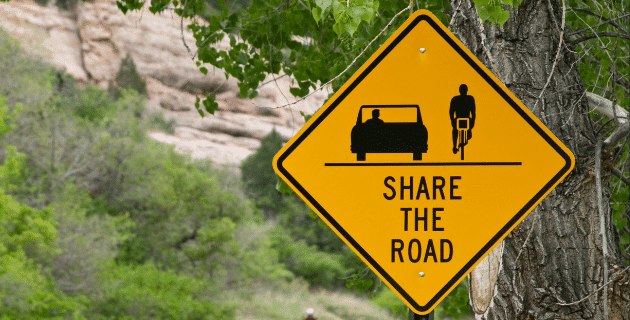
by California Casualty | Auto Insurance Info |
When it comes to sharing the road with others, let’s face it, we don’t always know what (or whatnot) to do. Ask anyone who has ever been behind a slow-moving vehicle or who has tried to pass an 18-wheeler…
Here’s a quick guide on the rules of the road as they pertain to sharing it with trucks, buses, motorcycles, bicycles, slow-moving vehicles, and pedestrians—plus a final word on the importance of moving over for emergency vehicles.

Trucks
A big rig weighs considerably more than the average car, and could be as much as 20-30 times heavier, according to the Federal Motor Carrier Safety Administration. Their significant size and weight affect how quickly they can stop, go, and maneuver with lane changes and turns. Despite mirrors and a bird’s eye view, trucks also have large blind spots. And if your car is in one, the trucker likely has no idea you’re there.
-
- Don’t cut off a truck by driving into the empty space just in front of them. While it takes a normal passenger car traveling at 65 mph about 300 feet to stop, it takes double that distance for a fully loaded commercial truck at the same speed. If you’re too close, the truck may not be able to slow down and avoid a collision.
- Do not try to get past a truck to reach an exit or turn. Slow down and stay behind.
- Know the locations of a truck’s blind spots and avoid them. These are typically directly in front, directly behind, and along the sides, but especially the right side. The general rule is that if you cannot see the truck driver’s reflection in his or her side mirror, most likely he can’t see you.
- The longer the vehicle, the greater the turning path will be. Big rig drivers often swing wide to make a turn. That means swinging left just before turning right. Watch the trucker’s turn signals and expect the driver to swing the other way. Importantly, do not pass a truck while turning or you might find yourself in its path.
- Always pass a truck on the left side. Once you pass, do not linger. Move out ahead so the truck knows you are there.
- Do not tailgate. You may not have enough time to stop if the truck in front of you stops quickly.
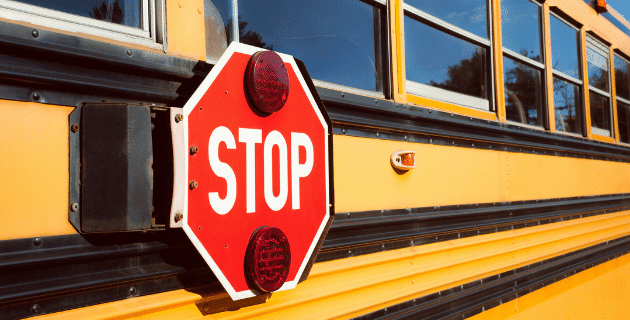
Buses
Buses face many of the same stopping and maneuverability issues that trucks do. The driver has the added pressure of being responsible for a busload of people—and sometimes children. With constant stops, and people getting on and off, there’s even more to consider when driving near a bus.
-
- School buses have warning lights. A flashing yellow means slow down; a flashing red means stop. Stop no matter where your vehicle is, including if it is alongside the bus.
- Remember that it is illegal to pass a school bus that has stopped to pick up or drop off children.
- Expect that public buses also will stop frequently. Maintain a safe distance behind them.
- Large vehicles like buses have a higher center of gravity and must travel more slowly around curves and on-ramps. If you’re behind them, adjust your speed. Do not cut them off.
- Remember that buses have large blind spots too, similar to trucks. They are usually immediately behind the side flat mirrors and behind the rear bumper. Try to stay visible and avoid those areas.
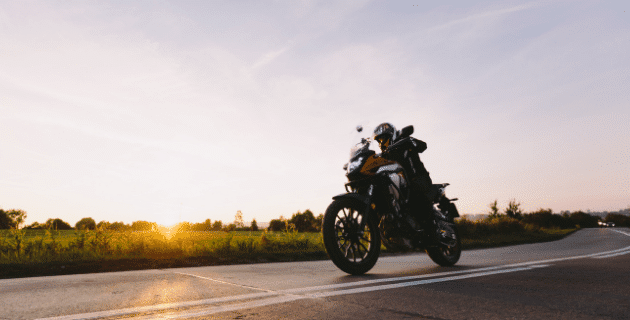
Motorcycles
Motorcycles are smaller than cars and significantly smaller than trucks and buses. So, it’s easy to see how they could almost “disappear” in your blind spots. Motorcycles can come up quickly without you realizing they’re there. That’s why it’s always good to be extra observant and know every vehicle sharing the road with you.
-
- Do a visual check and use your mirrors when you change lanes, enter a major road or make a turn.
- Allow motorcycles to have the width of the full lane width when possible.
- Never try to pass a motorcycle that is sharing the same lane as you. Move to one side to give them the room to pass.
- Road conditions can cause motorcycles to change speed or direction suddenly. These include wet slippery surfaces, gravel, and potholes. Anticipate this and be ready to adjust your speed and lane accordingly.
- When you park your car, look for motorcycles before opening your car door.
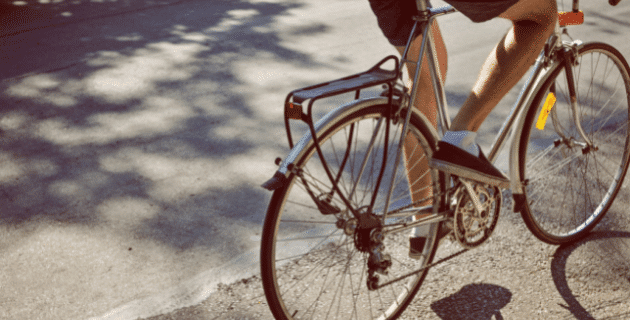
Bicycles
Bicycles have the right to be on the road with other vehicles, providing that they are following the rules. This includes proper lighting and reflectors at night, riding in the direction of traffic, signaling when changing lanes, and staying as near to the right curb as possible. In some cases, bicyclists may have a dedicated bike lane.
-
- Be aware that bicyclists may be permitted to ride on certain sections of highways where there is no alternate route and where bicycling is not prohibited by a sign.
- As with cars, bikes are required to signal turns. A left turn is the left arm extended to the side. A right turn is the left arm bent at a 90-degree angle with the hand at the top. The stop signal is the same with the hand at the bottom. Learn the hand signals so you know what the cyclist is communicating.
- Remember that your car weighs about 20 tons and a bike can weigh 20 lbs. or even less. Your car can do severe damage to a bicyclist and bike.
- Some states have laws about the amount of space you must give bicyclists. The general rule is to give them about 3 feet of clearance.
- After you park, look before you open your car door. There might be a bike coming.
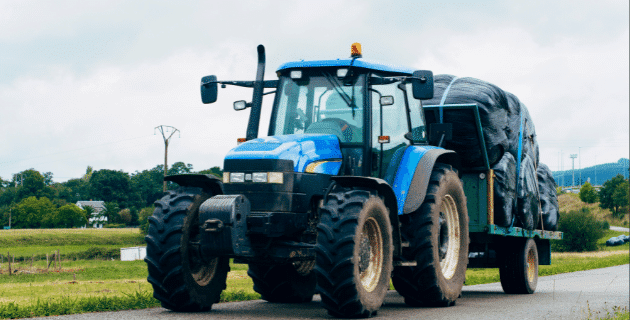
Slow-Moving Vehicles
It can be frustrating to be stuck behind farm tractors, animal-drawn carts, or road maintenance trucks. These slow-moving vehicles typically will display a reflective orange triangle so you are aware of their speed as you approach them.
-
- Slow down. Reduce your speed before you reach the slow-moving vehicle.
- Don’t sound your horn. You could scare a horse, and sounding a horn will not help a slow-moving vehicle move any faster.
- Be aware that animal-powered vehicles could make sudden movements.
- If there is enough room to pass them, do so carefully on the left.
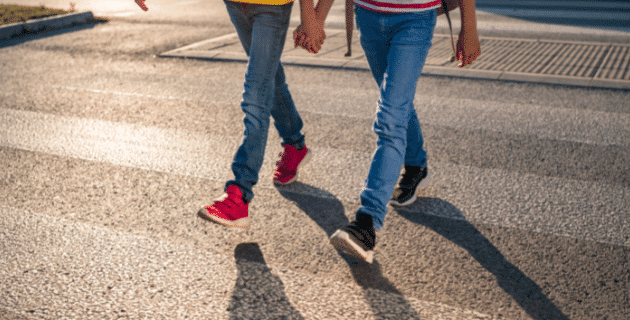
Pedestrians
Vehicles commonly share the road with pedestrians when they are crossing the street. Typically, this would be at a crosswalk. Check your local laws. In some cases, pedestrians do not always have the right of way. However, drivers do have a responsibility to be aware of people walking so they do not hit them.
-
- Stop at all crosswalks where pedestrians are waiting.
- Make sure your car is within 5 feet of the crosswalk. This helps blind pedestrians sense the presence of your vehicle.
- Do not turn before looking for pedestrians.
- Use extra caution in low visibility situations such as dusk, nighttime, or in bad weather. There may be a pedestrian whom you do not see.
- Never pass vehicles stopped at a crosswalk. They could be stopping for someone.
- Leave room. Consider a vehicle emergency braking with pedestrian and cyclist detection.
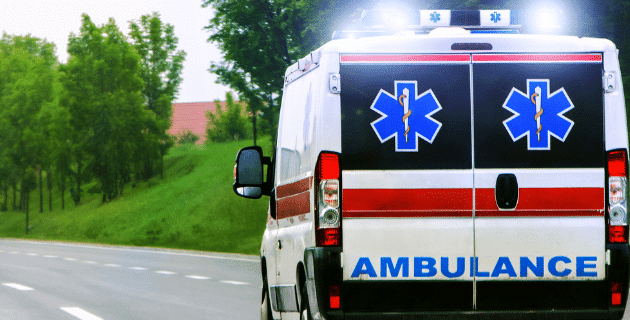
Emergency Vehicles
Police cars, fire engines, and ambulances need to get to the places where they can provide help to people in need. When you see flashing lights or hear sirens, that’s your cue to pull over to the side of the road. You can help emergency vehicles by giving them a clear path to their destination.
Following these rules for sharing the road will help keep you safe. Having the right auto insurance policy will provide peace of mind should you need that coverage. Safe travels.
This article is furnished by California Casualty, providing auto and home insurance to educators, law enforcement officers, firefighters, and nurses. Get a quote at 1.866.704.8614 or www.calcas.com
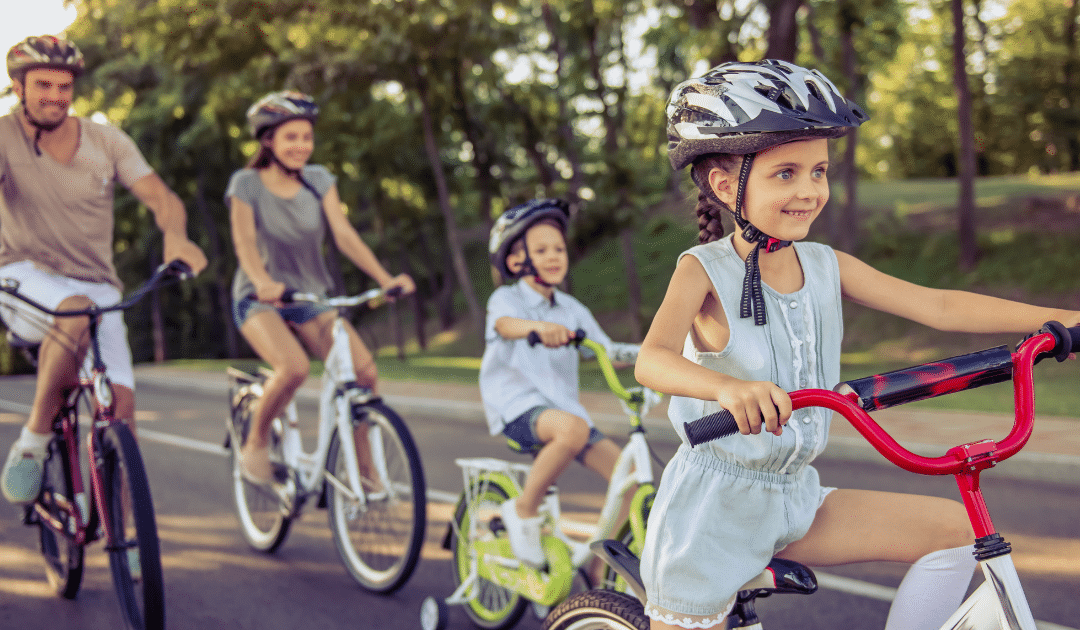
by California Casualty | Auto Insurance Info |
As more cyclists (of all ages) take to the road to enjoy the nice weather, now is a great time to brush up on the rules for safely sharing the streets.
Think of bikes as cars, but with fewer safety features. Road hazards such as potholes and debris may cause a cyclist to suddenly swerve, much like if they were driving a vehicle. And although riding on the right side of the lane is preferred for bike traffic, there may be the occasion when cyclists take to the center if road conditions require it.
Understanding cyclists and anticipating their next move will help you safely share the road. Here are some quick safety reminders on driving with cyclists this summer.
1. They have the right to “drive” in your lane, but they also need their space. Always give cyclists the right of way. Be sure to watch your speed compared to theirs. Pass only when there’s ample room (at least 3 feet between you and their bike) and while other vehicles are not approaching.
2. Look for bicyclists everywhere. Cyclists may not be riding where they should be or may be hard to see—especially in poorly lit conditions, including dusk/dawn/night and even in inclement weather.
3. Avoid turning in front of a bicyclist who is traveling on the road or sidewalk, often at an intersection or driveway. An oncoming cyclist may be traveling faster than you think. Drivers turning right on red should look to the right and behind to avoid hitting a bicyclist approaching from the right rear. Stop completely and look left-right-left and behind before turning right on red.
4. Completely stop at red lights or stop signs to let bikers pass or check for unseen bikers. Make eye contact with cyclists at intersections or crosswalks to acknowledge their presence and signal to let them know they are free to pass.
5. Don’t honk at someone on a bike. The noise could startle them, making them lose control of the bike they are riding. If it’s absolutely necessary, do so from a distance and make it a light tap.
6. Take extra precautions if you are sharing the road with children riding their bikes. They are smaller and harder to spot on the road, especially for drivers of bigger cars. Plus, these young bicyclists won’t have the same control over their bikes or know the rules of the road as mature riders.
7. Knowledge of common biking hand signals is a must. These include sticking the left arm straight out to indicate a left turn, holding the left arm up at a 90-degree angle to indicate a right turn, and pointing the left arm down at a 90-degree angle to indicate a stop or slowing down.
Taking extra precautions when you are behind the wheel and understanding a cyclist’s next move can help you avoid an accident. Use these tips this summer to help you both navigate the road ahead safely and seamlessly.
This article is furnished by California Casualty, providing auto and home insurance to educators, law enforcement officers, firefighters, and nurses. Get a quote at 1.866.704.8614 or www.calcas.com.
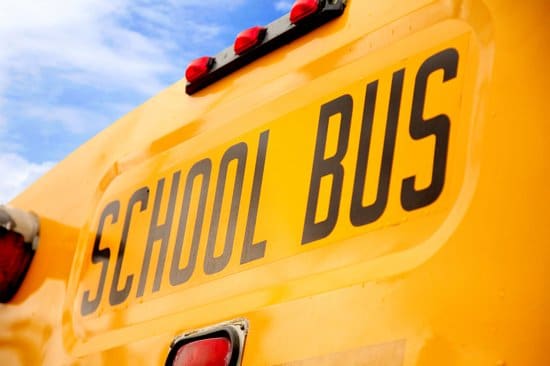
by California Casualty | Safety |
The hustle and bustle of the first days of the new school year can get a little crazy. Kids are racing to see their friends, buses are crisscrossing the area picking up and dropping off students and hurried parents are trying to drop their kids off before they have to head to work. Paying attention often goes by the wayside.
This is why it’s more important than ever to practice extreme caution around school zones and neighborhoods.
The National Safety Council warns that more children are hit by cars near schools than at any other location. That’s why they ask that drivers:
-
- Don’t double park because it blocks visibility
- Don’t load or unload children across the street from schools
- Carpool to reduce the number of vehicles at school
- Put down cell phones and other mobile devices
Other safety tips to prevent auto-pedestrian injuries around schools include:
-
- Not blocking crosswalks when stopped at a red light or making a turn forcing pedestrians to go around you; this could put them in the path of traffic
- Always stopping for school crossing guards
- Using extra caution to look out for children at bus stops, school zones, playgrounds and parks and in all residential areas
- Never passing a vehicle stopped for pedestrians
- Remembering that pedestrians have the right of way
And to prevent distracted walking and texting accidents, students are reminded to keep their head up and phone down and:
-
- Never walk while texting or talking on the phone
- Always move out of the way of others and stop on the sidewalk to text
- Never cross the street while using an electronic device
- Do not walk with headphones on
- Be aware of their surroundings
- Always walk on the sidewalk if one is available; if a child must walk on the street, he or she should face oncoming traffic
- Look left, right, then left again before crossing the street
- Cross only at crosswalks
Remember, the first days of school can be a dangerous time for excited students. Safety experts stress that we all need to slow down near school zones, wear seatbelts, leave early so we aren’t rushing and never drive distracted (texting, eating or drinking, horsing around with passengers or adjusting the radio or adjusting the navigation system).
This article is furnished by California Casualty, providing auto and home insurance to educators, law enforcement officers, firefighters, and nurses. Get a quote at 1.866.704.8614 or www.calcas.com.
by California Casualty | Calcas Connection, Good to Know |
You might be surprised to learn that school zones and bus stops are some of the most dangerous places for kids as they go to and from school. Since it’s been a few months since school has been in session, these safety refreshers can make this back to school season safer for our children:
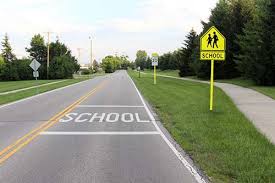 SCHOOL ZONES
SCHOOL ZONES
- Be aware of school zones
- Pay close attention to all school zones along your route. Warning signs, flashing lights and speed bumps are good indicators that a school zone is nearby.
- Never drive distracted, especially in areas where children travel to and from school
- Drinking coffee, texting, talking on the cell phone and completing the morning routine to get ready for the day (applying makeup or shaving) are all distractions.
- Slow down and observe school zone speed limits
- Avoiding the need to rush by building in extra time can save a life. Slamming on the brakes is not the best approach to reducing your speed in a school zone.
- Be patient and expect increased traffic during drop-off and pick-up times
- Don’t get overwhelmed by the controlled chaos. Your patience is greatly appreciated.
- Avoid double parking or blocking crosswalks in school drop-off zones
- Always yield to pedestrians, whether or not they are in the designated crosswalks.
 BUS STOPS
BUS STOPS
- Yield to buses at all times
- Filled with precious cargo, they deserve the right of way.
- Stop when you see school bus yellow or red flashing lights and the stop arm extended
- Drivers behind the bus as well as those approaching it are required to stop.
- Let students getting off of the bus cross in front of your car and wait to ensure all riders have crossed safely
- Stopping a good distance from the bus will help you to see the students and the students to see you
- Be aware of kids standing at bus stops
- They may accidentally step off of the curb and into your path. Be ready.
Nothing is more valuable than the lives of our children. These simple rules can prevent tragedies and keep our school zones safer for all.
TAKEAWAY: Find a great back to school safety resource at https://www.nsc.org/home-safety/seasonal-safety/back-to-school/drivers

by California Casualty | Helpful Tips |
Holiday parties are all about good company, great memories — and that one dish everyone can’t stop talking about. If you’re searching for the perfect potluck recipe to wow a crowd, you’re in the right place. We’ve scoured the internet for festive favorites that travel well, taste amazing, and disappear fast.
Appetizers
Hot Crab Pinwheels
These warm, melty bites deliver a burst of creamy crab flavor that disappears from the platter in minutes.
Ingredients:
- 1 package (8 ounces) reduced-fat cream cheese
- 1 can (6 ounces) crabmeat, drained, flaked and cartilage removed
- ¾ cup diced sweet red pepper
- ½ cup shredded reduced-fat cheddar cheese
- 2 green onions, thinly sliced
- 3 tablespoons minced fresh parsley
- ¼ to ½ teaspoon cayenne pepper
- 6 flour tortillas (6 inches)
Directions:
- Beat cream cheese until smooth. Then stir in crab, red pepper, cheese, green onions, parsley and cayenne.
- Spread 1/3 cup filling over each tortilla and roll up tightly.
- Wrap in plastic, twisting ends to seal. Refrigerate for at least 2 hours.
- When ready to bake, preheat the oven to 350 degrees.
- Unwrap rolls, trim ends and cut each into 6 slices.
- Coat cookie sheet with cooking spray. Place rolls on cookie sheet and bake until bubbly, about 10 minutes. Serve warm.
Pro tip: Bring the refrigerated rolls to the party and finish them in the host’s oven.
Muffin Tin Latkes
Crispy on the edges and tender inside, these muffin-pan latkes bring a fun twist to a beloved classic.
Ingredients:
- ¼ cup vegetable oil
- 12 ounces russet potatoes (2-3 potatoes)
- 1 large onion
- ¼ cup all-purpose flour
- 1 ½ teaspoons kosher salt
- 1 ½ teaspoons freshly ground black pepper
- 1 large egg, lightly beaten
- Sour cream, cooked apples, caramelized onions and/or chopped chives for serving
Directions:
- Place oven rack in the top position and preheat oven to 425 degrees. Generously spray a 12-cup muffin pan with nonstick cooking spray. Add 1 tsp. oil to each muffin cup. Put the muffin tin on a rimmed baking sheet and set aside.
- Peel the potatoes. Use a grater or a food processor to shred them. Then shred the onions and add them to the potatoes in a medium bowl.
- Add the flour, salt, pepper and egg and mix.
- Scoop a ¼ cup of the potato mixture into each muffin cup, pressing it into the bottom and against the sides.
- Bake until the latkes are a deep golden brown and the oil is sizzling, about 40-50 minutes.
- To ensure the latkes don’t stick, run a knife around and under each after you take them out of the oven, and move them to a cooling rack. Add your favorite toppings when serving.
Pro Tip: Make these up to 2 days ahead and store them tightly wrapped in the refrigerator. Just reheat on a baking sheet at 350 degrees, about 20 minutes.
Main Dishes
Skillet Cheeseburger Hot Dish
All the flavors of your favorite backyard burger come together in one bubbling, crowd-pleasing skillet.
Ingredients:
- 1 28-oz. bag frozen potato tots
- 1 medium red onion, chopped and divided
- 3 pickle brine, divided, plus 6 pickle chips, chopped
- 1 olive oil
- 1 ½ lb. 90% lean ground beef
- 2 steak seasoning
- 3 tomato paste
- 2 all-purpose flour
- 1 ½ tsp. beef bouillon base mixed with 1 ½ cup warm water
- 6 Cheddar cheese, coarsely grated (1 ½ cup) and divided
- ¼ cup mayonnaise
- 3 ketchup
- 1 yellow mustard
- 4 Campari tomatoes, chopped
Directions:
- Heat oven to 425 degrees.
- Put tater tots on a rimmed baking sheet and bake until crispy, about 25-30 minutes.
- In a small bowl, combine half of the onion with 2 tablespoons of pickle brine. Set aside.
- Heat oil in cast iron skillet. Add remaining onion and cook until tender and golden, 6-7 minutes. Add beef and steak seasoning and cook until the meat is no longer pink.
- Add tomato paste until caramelized and darkened in color. Sprinkle with flour. Gradually add bouillon mixture and simmer. Stir until slightly thickened.
- Sprinkle with 1 cup cheese and top with tots, then the remaining ½ cup cheese. Bake until cheese is melted and mixture is bubbling.
- In a small bowl, whisk together the mayonnaise, ketchup, mustard, and remaining tablespoon pickle brine. Drain pickled onions, then scatter over tots along with tomatoes and pickles. Serve with the special sauce on the side.
Turkey and Stuffing Casserole
This cozy casserole layers all the comfort of a holiday dinner into one hearty, shareable dish.
Ingredients:
Casserole:
- 2 tablespoons EVOO
- 2 tablespoons butter
- 2 pounds ground turkey at room temp and patted dry
- 2 teaspoons Worcestershire sauce
- Salt and freshly ground black pepper
- 2 ribs celery, chopped
- 1 carrot chopped
- 1 onion chopped
- 1 small potato, peeled and chopped
- 2 tablespoons finely chopped fresh thyme
- 2 tablespoons flour
- 2 to 2 ½ cups turkey or chicken stock
- ½ cup frozen peas
Stuffing:
- 6 tablespoons butter cut into pieces
- 3-4 ribs celery with leafy tops, chopped
- 2 small apples, such as Macintosh or Honeycrisp, chopped
- 1 large fresh bay leaf
- 1 onion chopped
- About 1 tablespoon poultry seasoning
- Salt and freshly ground pepper
- 1 bag traditional seasoned stuffing mix or 5 cups cubed stale bread
- About 3 cups of turkey or chicken stock
- Butter for dotting casserole
Directions:
- Preheat the oven to 375 degrees.
- Heat the EVOO in a large, deep skillet over medium high heat. Melt in the butter.
- Add the turkey and cook until browned. Season with the Worcestershire, salt and pepper.
- Add the celery, carrots, onions, potatoes and thyme. Cook 8-10 minutes until vegetables are softened.
- Stir in the flour and cook for a minute, then add the stock and cook to thicken.
- Stir in the peas until warmed through and transfer the mixture to a casserole dish.
- For the stuffing, heat a large skillet and melt the butter on medium heat. Add the celery, apples, bay leaf and onions.
- Add the poultry seasoning and salt and pepper. Cook until tender, 12-15 minutes. Then add the stuffing mix or bread to moisten in the stock.
- Arrange the stuffing on top of the casserole and dot with butter.
- Bake until brown, bubbly and crisp on top, about 15 to 20 minutes.
Pro Tip: If baking later, refrigerate the casserole. On party day, plan to bring the casserole to room temperature and follow baking instructions above at your home or the host’s.
Side Dishes
Sweet Onion Creamed Corn
Sweet, smoky, and irresistibly creamy, this upgraded corn dish steals the show on any potluck table.
Ingredients:
- 5 bacon strips, chopped
- 1 large, sweet onion, chopped
- 1 medium sweet red pepper, chopped
- 5 cups frozen corn (about 24 ounces), thawed
- 2 cups cubed fully cooked ham
- ½ cup half-and-half cream
- 1 tablespoon brown sugar
- 1 tablespoon dried parsley flakes
- 1 teaspoon smoked paprika
- ½ teaspoon salt
- ½ teaspoon pepper
- 1 package (8 ounces) cream cheese, cubed and softened
Directions:
- Cook bacon over medium heat until crisp. Remove with slotted spoon, leaving drippings in the pan.
- Cook and stir onion and sweet red pepper in bacon drippings over medium high heat until tender, about 5-6 minutes.
- Grease a 4-quart slow cooker. Combine corn, ham, cream, brown sugar, parsley, paprika, salt, pepper, bacon and onion mixture. Cook covered on low for 3-4 hours.
- Stir in cream cheese and cook 10 minutes longer. Stir before serving.
Broccoli Rice Casserole
Packed with cheesy goodness and wholesome veggies, this casserole is the kind of side everyone goes back for
Ingredients:
- 4 Tbsp. (½ stick) salted butter
- 1 medium yellow onion, finely diced
- 1 garlic clove, grated
- 4 Tbsp. all-purpose flour
- ½ tsp. dry mustard
- ¼ tsp. cayenne pepper
- 3 cups whole milk
- 4 oz. cream cheese, at room temperature
- ½ cup grated parmesan cheese
- 1 tsp. black pepper
- ½ tsp. kosher salt
- ½ tsp. paprika
- 8 oz. processed cheese (Velveeta), cubed
- 3 cups grated sharp cheddar cheese (about 12 ounces)
- 8 cups small broccoli florets
- 6 oz. diced pimentos, drained
- 2 ½ cups cooked long-grain rice
Directions:
- Preheat oven to 350 degrees.
- Melt the butter in a large skillet over medium heat. Add the onion and garlic and cook until softened, about 3-4 minutes.
- Add the milk, stirring constantly. Cook until thickened, about 2 minutes.
- Add the cream cheese and parmesan. Stir in the pepper, salt and paprika.
- Add the processed cheese, stirring until melted. Then add 1 ½ cups cheddar and stir until melted.
- Fold in the broccoli and pimentos.
- In a large baking dish, create a base with half the cooked rice. Top with half of the broccoli cheese sauce. Repeat.
- Sprinkle the remaining 1 ½ cups cheddar over the top. Bake until bubbly, about 30 minutes.
Desserts
Candy Cane Pie
This make-ahead, no-bake pie is the perfect festive touch for any holiday gathering.
Ingredients:
- 25 chocolate sandwich cookies (such as Oreos; about 9.5 ounces)
- 5 unsalted butter, melted
- 2 ½ cups heavy cream
- 1 cup powdered sugar
- 3/4 cup white chocolate chips
- 12 cream cheese, at room temperature
- 1 peppermint extract
- ½ cup coarsely crushed candy canes (from 8 candy canes), plus more for garnish
- Red gel food coloring, for the filling
- 2 mini candy canes, for garnish (optional)
Directions:
- Pulse the cookies in a food processor until fine crumbs form. Pour in melted butter and pulse until combined. Press the mixture firmly in a 9-inch-deep dish pie plate. Cover the crust and place it in the freezer for at least 15 minutes and up to a day.
- Whip the heavy cream and ½ cup of the powdered sugar on medium-high until stiff peaks form, about 3 minutes. Set aside.
- Microwave the white chocolate chips in 15-second intervals, stirring between each, until fully melted. Let cool for 2-3 minutes.
- Combine the cream cheese, peppermint extract, and remaining ½ cup powdered sugar. Beat on medium high speed until light, fluffy and smooth, about 2 minutes. Add the melted white chocolate and mix on medium speed.
- Carefully fold in 3 cups of the whipped cream. Cover and refrigerate the remaining whipped cream.
- Transfer half of the peppermint filling to a medium bowl. Fold in crushed candy canes and spread the mixture in the chilled pie shell. Freeze for 10 minutes.
- Add red food coloring to the remaining filling, mixing gently to avoid deflating. Spoon the pink filling over the chilled pie. Cover and refrigerate for 8 hours.
- Whisk the reserved whipped cream mixture back to stiff peaks. Dollop on the pie and decorate with crushed candy canes.
Layered Chocolate Marshmallow Peanut Butter Brownies
Swirls of chocolate, peanut butter, and marshmallow make these brownies an indulgent, show-stopping treat.
Ingredients:
- 1 ½ cups butter, divided
- 3/4 cup baking cocoa, divided
- 4 large eggs, room temperature
- 2 cups sugar
- 1 teaspoon vanilla extract
- 1 ½ cups all-purpose flour
- ½ teaspoon salt
- 1 jar (16.3 ounces) chunky peanut butter
- 1/3 cup 2% milk
- 10 large marshmallows
- 2 cups confectioners’ sugar
Directions:
- Preheat oven to 350 degrees.
- In a small saucepan, melt 1 cup of butter. Stir in ½ cup of cocoa until smooth. Remove from heat.
- In a large bowl, beat eggs, sugar and vanilla until blended.
- Combine flour and salt and gradually add it to the egg mixture.
- Beat in cocoa/butter mixture.
- Transfer to a greased 15x10x1 pan. Bake until the center comes out clean, about 18-22 minutes.
- Cool brownies on a wire rack. Microwave peanut butter until softened, about 30 seconds and spread on warm brownies. Refrigerate until peanut butter is set, about 45 minutes.
- In a saucepan, combine milk, marshmallows, remaining ¼ cocoa and remaining ½ cup butter. Stir over medium low heat until the mixture is smooth. Remove from heat and gradually stir in confectioner’s sugar. Spread over peanut butter layer.
- Refrigerate at least 30 minutes. Cut in squares and serve.
Have a go-to dish that always earns compliments? We’d love to hear it. Share your favorite holiday recipe in the comments.
Happy holidays from all of us at California Casualty!
This article is furnished by California Casualty, providing auto and home insurance to educators, law enforcement officers, firefighters, and nurses. Get a quote at 1.866.704.8614 or www.calcas.com.











 SCHOOL ZONES
SCHOOL ZONES BUS STOPS
BUS STOPS